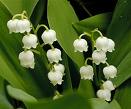Convallaria (kon val AIR ee a)from the Latin word convallis meaning valley + the suffix aria meaning a place containing

In Song of Solomon 2.1 of the Vulgate Bible the plant Lilium convallium is mentioned and translated as lily of the valley. It is doubtful, however, that the plant in the biblical text is the one we know today by that name. Other names for lily of the valley include Lady’s tears and Mary’s tears both of which may refer to the tears of the Virgin Mary during the crucifixion of Jesus. Alternatively, Lady’s tears may refer to the tears of Eve when she and Adam were expelled from the Garden of Eden.
The genus Convallaria is a rhizomatous herbaceous perennial native to the temperate parts of the Northern Hemisphere and is often grown as a ground cover. It grows best where summers are warm but not hot and it can form extensive colonies. Although formerly in the lily family, Liliaceae, it is now placed in the asparagus family, Asparagaceae, that also includes hosta, hyacinth, and agave. Convallaria is a small genus with only one or three species with C. majalis being the most common and popular. Plants grow about twelve inches high and have one to three basal leaves that are broadly lanceolate and about eight inches long. Five to fifteen nodding flowers are carried on one sided arching racemes in early spring. The bell-shaped flowers are usually white, sometimes pink, and consist of five fused tepals. They are very fragrant, inspiring a perfume by Dior, and use in wedding bouquets by both Grace Kelly and Catherine Middleton. Lily of the valley has also been chosen as the floral emblem of Yugoslavia, the national flower of Finland, part of the coast of arms for a municipality in Norway, the birth flowers for the month of May, and the most sought after flower in France for Labor Day, May 1. In the language of flowers, lily of the valley stands for purity, delicacy, and the return of happiness in memory of the legendary nightingale that returned to the woods only in May when the flower bloomed.
Plants thrive in USDA Zones 2-5, do well in 6-7, and struggle in 8. They need semi-shade and consistently moist conditions. Several cultivars are available including ones with light pink flowers, cream colored double flowers, variegated leaves, and greater height.